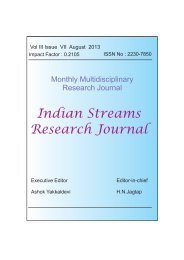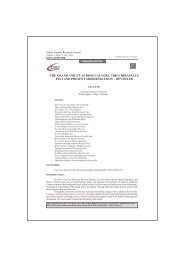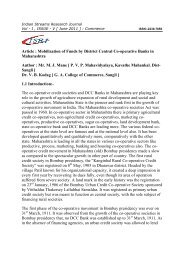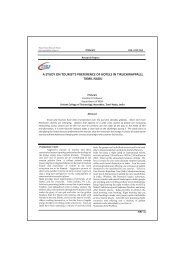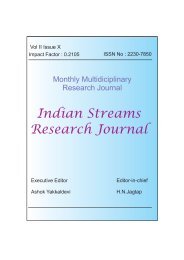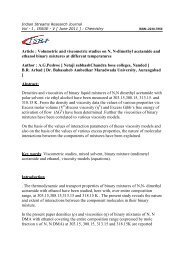Article : Self concept of high and low achieving adolescents Author ...
Article : Self concept of high and low achieving adolescents Author ...
Article : Self concept of high and low achieving adolescents Author ...
Create successful ePaper yourself
Turn your PDF publications into a flip-book with our unique Google optimized e-Paper software.
Indian Streams Research JournalVol - I , ISSUE - IV May 2011 : PsychologyISSN:-2230-7850<strong>Article</strong> : <strong>Self</strong> <strong>concept</strong> <strong>of</strong> <strong>high</strong> <strong>and</strong> <strong>low</strong> <strong>achieving</strong> <strong>adolescents</strong><strong>Author</strong> : Dr.R.K.Adsul [ Smt. Mathubai Garware Kanya Mahavidyalaya,Sangli ]Present study was undertaken to measure the self <strong>concept</strong> <strong>of</strong> <strong>high</strong> <strong>and</strong> <strong>low</strong> achieversecondary school students in Sangli district. For that purpose 400 students <strong>of</strong> Xthclass were selected r<strong>and</strong>omly from different schools <strong>of</strong> sangli district.Of these400Ss,50%were boys <strong>and</strong> 50% were girls. Thus male female ratio was 1:1 <strong>and</strong> agerang was 14 to 16years.Rajkumar Saraswat questionnaire used for measuring self<strong>concept</strong> <strong>of</strong> Ss.Results revealed that there is no significant difference between <strong>high</strong>& <strong>low</strong> achievers on self-<strong>concept</strong>s namely-physical, social, emotional, moral <strong>and</strong>educational self-<strong>concept</strong>s. But it is found that there is significant difference in <strong>high</strong>& <strong>low</strong> achievers on intellectual self-<strong>concept</strong>.Key Words :<strong>Self</strong> <strong>concept</strong>, <strong>high</strong> <strong>and</strong> <strong>low</strong> achievers-----------------------------------------------------------------------------------------------------------Studies <strong>of</strong> the relationship between self-<strong>concept</strong> <strong>and</strong> achievementin educational settings have been a major focus <strong>of</strong> research <strong>and</strong> theory for manyyears (Hamachek, 1995; House, 1996; Hattie, 1992; Marsh et al., 1988; Burns,1979). Research has supported the belief that there is a persistent <strong>and</strong> significantrelation between the self-<strong>concept</strong> <strong>and</strong> academic achievement. Fink, (1962); Doyle<strong>and</strong> Purkey (1970) have documented a significant relationship among variablessuch as academic achievement, school satisfaction, <strong>and</strong> self-<strong>concept</strong>. It has alsobeen noted that this relationship has been reported for children all grade levels,from the primary grade levels through college (Mc C<strong>and</strong>less <strong>and</strong> Evans, 1973;Adeniran, 1985; Salawn, 1991). Academic success <strong>and</strong> positive self-<strong>concept</strong> havealso been shown to be positively correlated in Black <strong>and</strong> Hispanic children(Vasquez, 1974; Borovetz, 1975). Ram Kumar (1972) found positive <strong>and</strong>significant relationship between self-<strong>concept</strong> <strong>and</strong> academic achievement. Sharma(1979) reported that self-<strong>concept</strong> affects academic achievement.
Indian Streams Research JournalVol - I , ISSUE - IV May 2011 : PsychologyISSN:-2230-7850Calsyn <strong>and</strong> Kenny (1977) stated that self-<strong>concept</strong> whether <strong>high</strong> or <strong>low</strong>, is a primarypredictor <strong>of</strong> achievement levels. Accordingly, if a student with special needs enteran already <strong>low</strong> self-<strong>concept</strong> his or her academic performance could be similarly<strong>low</strong>ered.Bolus (1982) found that grades in English, mathematics <strong>and</strong> science were more<strong>high</strong>ly correlated with matching areas <strong>of</strong> self-<strong>concept</strong> than with general self<strong>concept</strong>Byrne (1984) found that nearly all studies report that self-<strong>concept</strong> is positivelycorrelated with achievement <strong>and</strong> many find achievement to be more stronglycorrelated with academic self-<strong>concept</strong> than with general self-<strong>concept</strong>.Pathani, R.S (1985) designed to study the effect <strong>of</strong> identity versus roleconfusion, self-<strong>concept</strong> <strong>and</strong> need (self-actualization) on academic achievement <strong>of</strong><strong>adolescents</strong>. The sample <strong>of</strong> the study consisted <strong>of</strong> 700 <strong>adolescents</strong> (360 boys <strong>and</strong>340 girls) studying in intermediate colleges. The finding revealed that self-<strong>concept</strong>was a significant predictor <strong>of</strong> academic achievement.Eitan etal. (1992), examined academic <strong>and</strong> social self-<strong>concept</strong> <strong>of</strong> 594 Israeli7 th grade children. Results indicate that <strong>low</strong> <strong>achieving</strong> students <strong>of</strong> Middle Easternbackground only in the comparison group sustained a significant negative changein their social <strong>and</strong> academic self-<strong>concept</strong>s.Trusty, Peak; <strong>and</strong> Mathew (1994) investigated the relationship amongachievement, SES <strong>and</strong> self-<strong>concept</strong> in 392 fourth graders. Results indicate that <strong>low</strong><strong>achieving</strong> <strong>low</strong> SES students generally had negative social <strong>and</strong> emotional selfperceptions whereas <strong>low</strong> <strong>achieving</strong> <strong>high</strong>er SES students had more negative schoolrelated self perceptions.Tiwari <strong>and</strong> Bansal (1994) from a sample <strong>of</strong> 885 girls <strong>of</strong> four different places <strong>of</strong> UPselected only 100 effective samples on the basis <strong>of</strong> marks obtained by them in UPBoard examination. On the basis <strong>of</strong> their marks 50 girls were treated as <strong>high</strong>achievers <strong>and</strong> 50 other were <strong>low</strong> achievers. Their self-<strong>concept</strong> was measured.High achievers exhibited superiors self <strong>concept</strong> as compared to the self-<strong>concept</strong>sexhibited by <strong>low</strong> achievers.Many studies illustrate the positive relation between school achievement<strong>and</strong> academic self-<strong>concept</strong> (Jones <strong>and</strong> Grineeks, Burns, 1979, Boxtel <strong>and</strong> Monks,1992). Low self-<strong>concept</strong> tends to appear together with students underachievement.
Indian Streams Research JournalVol - I , ISSUE - IV May 2011 : PsychologyISSN:-2230-7850Academic achievement was found to be having significant relationship withself-<strong>concept</strong> (Saraswat 1982; Desai <strong>and</strong> Uchat 1983; Panwar 1986; Lyon 1993;Kobal <strong>and</strong> Musek 2001; Trautwein etal. 2006 <strong>and</strong> Tracy 2007).Deshmukh, N.H (2000) designed to study to compare <strong>high</strong> <strong>and</strong> <strong>low</strong> self<strong>concept</strong>groups <strong>of</strong> junior college students with anxiety, achievement motivation,intelligence, goad discrepancy <strong>and</strong> academic achievement, 832 self-<strong>concept</strong>sscores <strong>of</strong> students are classified into two extreme groups viz. <strong>high</strong> <strong>and</strong> <strong>low</strong> P73 <strong>and</strong>P27 being the cutting points. Results reveal that <strong>high</strong> <strong>and</strong> <strong>low</strong> self-<strong>concept</strong> groups<strong>of</strong> Junior college students differ significantly on anxiety, n Ach, intelligence. Thesegroups do not differ significantly on goal discrepancy <strong>and</strong> academic achievement.Franzis etal. (2008) investigated gender differences in 181 gifted <strong>and</strong> 181 averageability 6 th graders in achievement, academic self-<strong>concept</strong> interest <strong>and</strong> motivation inmathematics. Researchers found that boys earned significantly <strong>high</strong>er score thangirls. Girls scored <strong>low</strong>er on measures <strong>of</strong> academic self-<strong>concept</strong> interest <strong>and</strong>motivation.In present study, an adolescent can make targeted self evaluations inphysical, social, intellectual, emotional, moral <strong>and</strong> educational domains. The stage<strong>of</strong> adolescence is regarded as one <strong>of</strong> the most important periods in the entire lifecycle. Due to rapid changes taking place in our society, the life styles <strong>of</strong>individuals have totally changed over the years. Adolescents are becoming morecareer minded, <strong>and</strong> academic achievement oriented. A child with <strong>high</strong> academicachievement is likely to be rated as capable individual. On the other h<strong>and</strong> a childwith poor academic achievement is likely to face adverse comments from parents,teachers <strong>and</strong> friends. These remarks from different people have marked influenceon <strong>adolescents</strong>’ self-<strong>concept</strong>. Therefore, the present study has been under taken“self-<strong>concept</strong> <strong>of</strong> <strong>high</strong> <strong>and</strong> <strong>low</strong> <strong>achieving</strong> <strong>adolescents</strong>”.AIM OF THE STUDY :The study intends to measure the self-<strong>concept</strong> <strong>of</strong> <strong>high</strong> achievers <strong>and</strong> <strong>low</strong>achievers <strong>of</strong> urban <strong>and</strong> rural secondary school students <strong>and</strong> to find out whetherthey differ from each other on the measures significantly or not.OBJECTIVE OF STUDY :
Indian Streams Research JournalVol - I , ISSUE - IV May 2011 : PsychologyISSN:-2230-7850To measure the difference in <strong>high</strong> <strong>and</strong> <strong>low</strong> <strong>achieving</strong> secondary school students onsix self- <strong>concept</strong>s, namely-physical, social, intellectual, emotional, moral <strong>and</strong>educational.HYPOTHESES :In the present research work, fol<strong>low</strong>ing hypotheses were formulated,1 High achiever students will show <strong>high</strong> physical self-<strong>concept</strong> than <strong>low</strong>achiever students.2 High achiever students will show <strong>high</strong> social self-<strong>concept</strong> than <strong>low</strong> achieverstudents.3 High achiever students will show <strong>high</strong> intellectual self-<strong>concept</strong> than <strong>low</strong> achieverstudents.4 High achiever students will show <strong>high</strong> emotional self-<strong>concept</strong> than <strong>low</strong> achieverstudents.5 High achiever students will show <strong>high</strong> moral self-<strong>concept</strong> than <strong>low</strong> achieverstudents.6 High achiever students will show <strong>high</strong> educational self-<strong>concept</strong> than <strong>low</strong>achieverstudents.METHOD:SAMPLE :The universe <strong>of</strong> the study was limited to the 10 th st<strong>and</strong>ard studentsenrolled in the secondary schools <strong>of</strong> Sangli city, Miraj <strong>and</strong> Tasgaon Taluka. Only
Indian Streams Research JournalVol - I , ISSUE - IV May 2011 : PsychologyISSN:-2230-7850the students enrolled in 10 th st<strong>and</strong>ard were included in the sample. List <strong>of</strong> thesestudents <strong>and</strong> percentage <strong>of</strong> marks obtained by them in the 9 th examination werecollected. All these students were arranged in hierarchical order on the basis <strong>of</strong>marks obtained by them in 9 th examination. Those who had obtained more than70% marks selected as <strong>high</strong> achievers <strong>and</strong> those who secured less than 45% marksas <strong>low</strong> achievers.The sample for the present study consisted <strong>of</strong> 400Ss,<strong>of</strong> which 50% wereboys <strong>and</strong> remaining were girls. Thus the male female ratio was 1:1. Age rang <strong>of</strong> theSs was 14 to 16 years.TOOLS USED FOR DATA COLLECTION:One st<strong>and</strong>ardized technique is used for collecting data. It is described be<strong>low</strong>.SELF-CONCEPT QUESTIONNAIRE (SCQ) :This inventory was constructed <strong>and</strong> st<strong>and</strong>ardized by Dr. Raj KumarSaraswat. It consists 48 items <strong>and</strong> six dimensions. Each dimension contains eightitems. Each item is provided with five alternatives. Responses are obtained on thetest booklet itself. There is no time limit but generally 20 minutes have been foundsufficient for responding all the items.This is widely used inventory for measuring self-<strong>concept</strong> <strong>of</strong> the Ss. The author hasgiven the scoring method for scoring the responses given by the Ss. The maximumobtained score is 240 <strong>and</strong> minimum 48. High score in this inventory indicates a<strong>high</strong>er self-<strong>concept</strong>, while a <strong>low</strong> score shows <strong>low</strong> self-<strong>concept</strong>. It is <strong>high</strong>ly reliableinventory. Reliability <strong>of</strong> the inventory was found by test- retest method 0.91 for thetotal self-<strong>concept</strong> measure. The reliability coefficient <strong>of</strong> various dimensions variesfrom 0.67 to 0.88.RESULTS AND DISCUSSION:Table 1:Mean, SD <strong>and</strong> ‘t’ value <strong>of</strong> six dimensions <strong>of</strong> self <strong>concept</strong> <strong>of</strong>academically <strong>high</strong> <strong>and</strong> <strong>low</strong> <strong>achieving</strong> <strong>adolescents</strong>.
Indian Streams Research JournalVol - I , ISSUE - IV May 2011 : PsychologyISSN:-2230-7850Sr.No. <strong>Self</strong> Academic<strong>concept</strong>achievers1. Physical HighN Mean SD ‘ t’ Level<strong>of</strong>significance20029.943.980.92 NSLow2. Social High20020029.5930.833.664.231.50 NSLow3. Intellectual High20020030.1731.824.473.821.95 0.05Low4. Emotional High20020031.0632.933.973.721.63 NSLow5. Moral High20020032.2832.514.203.111.77 NSLow6. Educational High20020031.9428.163.273.851.27 NSLow20027.614.73From the results given in table No.1 it is clear that with respect to physical self<strong>concept</strong><strong>of</strong> <strong>high</strong> achievers are not significantly differ from <strong>low</strong> achievers. Both <strong>high</strong><strong>and</strong> <strong>low</strong> achievers have above average physical self-<strong>concept</strong>. High achievershaving 29.95 mean score <strong>and</strong> 3.98 SD while <strong>low</strong> achievers having 29.60 meanscore <strong>and</strong> 3.66 SD. There was no significant difference on social self-<strong>concept</strong> in<strong>adolescents</strong> on the basis <strong>of</strong> the academic achievement. The obtained resultsindicate that both <strong>high</strong> <strong>and</strong> <strong>low</strong> achievers having similar level social self-<strong>concept</strong>that is above average. High achievers having 30.83 mean score <strong>and</strong> 4.24 SD while<strong>low</strong> achievers having 30.18 mean score <strong>and</strong> 4.47 SD on social self-<strong>concept</strong>. It isseen that the mean <strong>of</strong> intellectual self-<strong>concept</strong> <strong>of</strong> the <strong>high</strong> achievers is 31.83 withSD 3.82 while mean <strong>of</strong> intellectual self-<strong>concept</strong> <strong>of</strong> <strong>low</strong> achievers is 31.07 with SD3.98. Table value reveals that ‘t’ ratios between <strong>high</strong> <strong>and</strong> <strong>low</strong> achievers emergedsignificant (t = 1.95). It means that these two groups are significantly differentaccording with intellectual self-<strong>concept</strong>. In order to compare the emotional self<strong>concept</strong><strong>of</strong> <strong>high</strong> <strong>and</strong> <strong>low</strong> achievers ‘t’ value were computed <strong>and</strong> recorded in thetable. It appeared that mean value <strong>and</strong> S.D <strong>of</strong> <strong>high</strong> achievers is 32.94 <strong>and</strong> 3.73,while mean value <strong>and</strong> S.D <strong>of</strong> <strong>low</strong> achievers is 32.29 <strong>and</strong> 4.21 respectively. It isseen that the ‘t’ value 1.63 is not significant. The mean value <strong>and</strong> S.D <strong>of</strong> the moral
Indian Streams Research JournalVol - I , ISSUE - IV May 2011 : PsychologyISSN:-2230-7850self-<strong>concept</strong> <strong>of</strong> <strong>high</strong> achievers is 32.51 <strong>and</strong> 3.12 respectively, while mean values<strong>and</strong> S.D <strong>of</strong> the moral self-<strong>concept</strong> <strong>of</strong> <strong>low</strong> achievers is 31.95 <strong>and</strong> 3.28 respectively.‘t’ value 1.77 <strong>of</strong> mean difference for <strong>high</strong> <strong>and</strong> <strong>low</strong> achievers is found not to besignificant. It is found that level <strong>of</strong> academic achievement does not influence onthe educational self-<strong>concept</strong> <strong>of</strong> <strong>adolescents</strong>, because obtained ‘t’ value 1.27 wasfound not to be significant at any level <strong>of</strong> significance. Mean <strong>and</strong> S.D <strong>of</strong>educational self-<strong>concept</strong> for <strong>high</strong> achievers is respectively 28.16 <strong>and</strong> 3.85 whilemean <strong>and</strong> S.D for <strong>low</strong> achievers is respectively 27.61 <strong>and</strong> 4.73.Conclusion :Thus, it may be concluded that there is no significant difference between <strong>high</strong> &<strong>low</strong> achievers on self-<strong>concept</strong>s namely-physical, social, emotional & moral <strong>and</strong>educational, self-<strong>concept</strong>s. So hypothesis No. 1,.2, 4, 5, 6 are rejected. But it isfound that there is significant difference in <strong>high</strong> & <strong>low</strong> achievers on intellectualself-<strong>concept</strong>. So hypothesis No. 3 is accepted.REFERENCES:Adsul, R. K. (2009). Academic inferiors <strong>and</strong> superiors(psycho-socialstudy) Published by Sahityalok, Kanpur.Barooah, S. & Phukan, M. (1999). A comparative study <strong>of</strong> self-<strong>concept</strong> <strong>of</strong> orphanchildren <strong>and</strong> children with natural parents. Indian PsychologicalReview,52,74-78.Broota, K. D. (2002), Experimental Design in behavioural research, New age ,International (P) Limited, publishers, New Delhi.Best, J. Khan, J. (2008) Research in education, 10th edi. Prentice-hall <strong>of</strong> India, Pvt.Ltd.New Delhi.Bolus, R., & Shavelson, R.J. (1982). <strong>Self</strong>-<strong>concept</strong>; the interplay <strong>of</strong> theory <strong>and</strong>methods.Journal <strong>of</strong> Educational Psychology, 74, 3-17.
Indian Streams Research JournalVol - I , ISSUE - IV May 2011 : PsychologyISSN:-2230-7850Calsyn, R. J., & Kenny, D. A. (1977). <strong>Self</strong>-<strong>concept</strong> <strong>of</strong> ability & perceivedevaluationOf others, American Journal <strong>of</strong> educational Psychology, 36.Deshmukh, N. H. (2000). A Study <strong>of</strong> anxiety, achievement motivation,intelligence, goalDiscrepancy <strong>and</strong> academic achievement <strong>of</strong> junior college students with<strong>high</strong> <strong>and</strong>Low self-<strong>concept</strong>. Indian Psychological Review, 2, 2-6.Jagpreet, Kumar., Rana, J. S., & Rupinder, K. (2009) Home environment <strong>and</strong>academicAchievement as correlates <strong>of</strong> self-<strong>concept</strong> among <strong>adolescents</strong>. Stud Home conomSci, 3, 13-17.Khab, M. A. (2005) Gifted achievers <strong>and</strong> underachievers on appraisal, Discoverypub.House New Delhi.Mangal, S. K. (2008) Advanced educational psychology, 2nd Edi: Prentice-Hall<strong>of</strong> India,New Delhi.Marsh, H. W., Parker, J. & Barnes, J. (1985). Multidimensional <strong>adolescents</strong> self<strong>concept</strong>:Their relationship to age, sex <strong>and</strong> academic achievement. AmericanEducationalResearch Journal, 25, 237-269.Marsh, H. W. (1993). Academic self-<strong>concept</strong>: Theory measurement <strong>and</strong> research.In J.
Indian Streams Research JournalVol - I , ISSUE - IV May 2011 : PsychologyISSN:-2230-7850Suls (Ed.), Psychological perspectives on the self. 4, 59-58Minium, E. King, B.; Bear, G. (2008) Statistical Reasoning in psychology <strong>and</strong>Education, 3rd Edi. Published by John Wiley & Sons, Inc.Parit, A. S. (1999) Effect <strong>of</strong> caste, SES, IQ <strong>and</strong> sex on self-<strong>concept</strong> <strong>of</strong> <strong>adolescents</strong>Unpublished Ph.D. thesis Shivaji University, Kolhapur.Pujar, V. Gaonkar. (2000). Influence <strong>of</strong> age <strong>and</strong> type <strong>of</strong> family on self-<strong>concept</strong> <strong>of</strong><strong>high</strong>And <strong>low</strong> achieveing <strong>adolescents</strong>, Indian psychological review, 54, 24-26.Ramkumar, V. (1972). <strong>Self</strong>-<strong>concept</strong> <strong>and</strong> level <strong>of</strong> aspiration as factors affectingacademicachievement. Journal <strong>of</strong> Psychological Research, 16.Rathaiah, L.; Rao, D. (1997) Achievement correlates, Discovery pub. Hou. NewDelhi.Saraswat, R. K. (1992). Manual for self-<strong>concept</strong> questionnaire, NationalPsychologicalCorporation, Agra.Sear, R. R. (1970). Relationship <strong>of</strong> early experiences to self-<strong>concept</strong> <strong>and</strong> genderrole,American Journal <strong>of</strong> child development, 41.Tiwari, Savita & Bansal, Indu. (1994). A study <strong>of</strong> self-<strong>concept</strong> <strong>of</strong> <strong>high</strong> <strong>and</strong> <strong>low</strong>Achievingadolescent girls. Indian Psychological Review, 43,21-25.Woon, C. L. Chee Keng, J. W. (2005). Academic self-<strong>concept</strong>: A cross-sectionalstudygrade <strong>and</strong> gender differences in a Singapore Secondary School. Asia pacific
Indian Streams Research JournalVol - I , ISSUE - IV May 2011 : PsychologyISSN:-2230-7850Education Review, 6, (1), 20-27.




